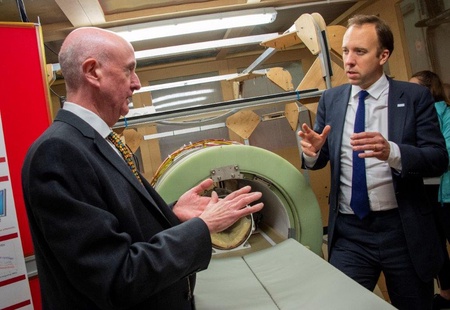Secretary of State for Health and Social Care, Matt Hancock, visited the University of Aberdeen to see first-hand the development of the next generation of MRI scanners.
Last week (May 30), Mr Hancock visited the Medical Physics department where the first full body MRI scanner was designed and built in the 1980s.
Head of department, Professor David Lurie, gave Mr Hancock an overview of the development of the next step in MRI technology, known as Fast Field Cycling MRI.
Current MRI scanners use a large magnet along with pulses of radiowaves to create detailed pictures of a patient’s anatomy. Whilst current MRI machines operate on a single strength of magnetic field, Fast Field Cycling MRI scanners are able to extract much more information by switching the strength of the magnetic field during the scanning procedure.
The technology has been under development for the last ten years.
The Aberdeen team behind FFC-MRI is leading a nine-strong consortium of research groups from six different countries across Europe, in a project called IDentIFY which received a €6.6 million Horizon 2020 research grant from the European Union to develop the imaging technology and bring it closer to widespread use in hospitals.
The first patients were scanned in the new machine in late 2017 and a project is currently under way to test its capabilities in detecting breast cancer.
Mr Hancock was joined by local MPs Andrew Bowie and Colin Clark.
Colin Clark MP commented: “This is a world class development and I am delighted SoS for Health was able to accept my invitation. Aberdeen Institute of Medical Science is the birth place of the MRI and this new Fast Field-Cycling MRI (FFC-MRI) scanner has national importance. MPs are always delighted to showcase the NE to Westminster ministers.”
Professor Lurie added: “It was fantastic to have the opportunity to give Mr Hancock an overview of this important technology which we believe can eventually be used in hospitals to produce more detailed information to help clinicians treat patients more effectively.”


